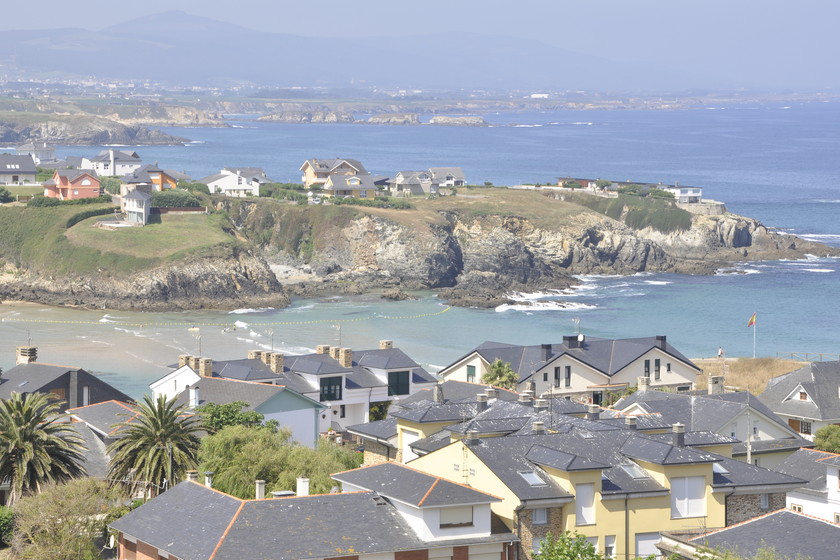There are 487 gold deposits in Asturias and the Romans knew it. They knew it so well that the easiest way to find an accumulation of minerals is to look at the map of the left mining remains. One of them was in Tapia de Casariego, on the shores of the Cantabrian Sea.
There, under the guise of an idyllic Asturian town, hides what is possibly the largest gold mine in Europe. 300,000 kilos of gold that are the object of desire of the mining industry of half the world and the nightmare of the inhabitants of the region.
The kingdom under the mountain
 Las Médulas, the captivating result of the Roman ‘ruin montium’
Las Médulas, the captivating result of the Roman ‘ruin montium’ Rome loved gold. Pliny the Elder, who was a solicitor in Hispania, recounted in his ‘Natural History’ that, during the first century of our era, the Empire was capable of extracting more than six tons of gold from the mines of the peninsular northwest each year.
We are talking about an industrial prodigy of the administrative machinery of the Empire that filled with scars not only Asturias, but all the territories surrounding the Mediterranean. Roman mining used primarily a method called ‘the collapse of mountains‘; This system uses the force of water to collapse large areas of geological structures with the least possible effort.

Las Médulas, in León, were the jewel in the crown of Roman gold mining, but in the Salave mines, in Tapia, the Romans also used themselves to great effect. They mobilized four million cubic meters of land forever changing the configuration of the terrain. It is little if we compare it with Las Médulas (where almost 100 million cubic meters were moved), but enough to extract about 7,000 kilos of gold.
Gold Rush
 Geological and Mining Institute of Spain | Via Luna Adrados
Geological and Mining Institute of Spain | Via Luna Adrados As Luna Adrados explained, after the Empire, the Salave mine was almost forgotten. The Tapia area has a relatively rare feature in Asturias, the floors are granite. That, which is what facilitated the creation of deposits of gold and other metals, has been what has ‘protected’ the mine over time. The rest of Asturian deposits, surrounded by sedimentary lands, were easier to exploit.

For this reason, since the Law of Mines was approved in Spain in 1825, the Salave mine has been the place where the great mining ambitions were to die. In 1850, the lagoons in the area were dried up to start a prospecting that did not come to fruition. Only between 1948 and 1952, in full Francoist autarky, the need for molybdenum (used in the iron manufacturing process) was such that it managed to reactivate the mine.
But the gold is still there

Since the 1960s, dozens of companies have toured the municipality of Tapia and have carried out more than 62km of surveys. Nothing prospered until in 2010 AsturGold proposed its project. As said many times, in the last 2000 years, never been so close to re-exploiting the Salave gold as at that time.

The issue is very controversial because 250 jobs (850 during construction) were heavenly music in much of western Asturias and the province of Lugo. However, environmental problems accumulate in an Asturias that tries to reconvert its dark industrial and mining past into a greener and healthier future. A mine, no matter how many controls it has, supposes an immense environmental and health impact.
AsturGold bet everything and started training its employees with a view to getting to work as soon as possible. Until in December 2014 the Principality of Asturias vetoed the exploitation. In February 2017 the Superior Court of the Principality confirmed the veto and everything seemed to indicate that the project was in a dead end.
 Asturias Green
Asturias Green It is not the case: the company announced that it was returning with external financial support. Neighbors fear environmental, health and quality of life degradation. And some already take for granted that, if the mine finally starts, the expropriation of their houses is a matter of time. For its part, the Principality established the conditions to allow extraction at the end of January 2020, but the pandemic left everything on hold. And so it goes months later.
What is clear is that Salave is a candy too juicy for mining to give up. According to the latest data, under the soil of Tapia there are at least 300,000 kilos of gold. In other words, with the current price, under the Tapia floor there are five billion euros.
